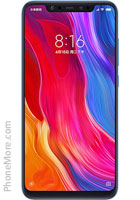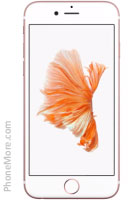Xiaomi Mi 8 (128GB) vs Apple iPhone 6S (64GB)
Side by side comparison between Xiaomi Mi 8 vs Apple iPhone 6S phones, differences, pros, cons and full specifications. What's the better?
,
6.21"
AMOLED
AMOLED
1080x2248
12
MP
MP
20mp
6GB
RAM
RAM
Octa-core
3400
mAh
mAh
(Non removable)
vs
4.7"
IPS
IPS
750x1334
12
MP
MP
5mp
2GB
RAM
RAM
Dual-core
1715
mAh
mAh
(Non removable)
What's the better phone? Xiaomi Mi 8 (128GB)
The phonemore's choice is much more technical than personal. Therefore, you shouldn't only consider this. Our goal is to help you, but what's important to us may not be important to you. You decide which one is the best! Comment!
| 28 Common items in both devices |
| Aluminum frame, glass front/back / Aluminum body, glass front |
| 60Hz |
| 16 million |
| Dual-LED flash |
| PDAF: phase detection autofocus |
| HDR photo on both cameras / HDR photo/video on both cameras |
| 4K UHD (3840x2160) |
| +21 specs and more in the table below |
Check the comparison table below for more items that are not evaluated in comparison score above.
Highlight differences Clear highlight📱 Model features | ||
| Xiaomi Mi 8 (128GB) | iPhone 6S (64GB) | |
| Model | Xiaomi Mi 8 (128GB) | iPhone 6S (64GB) |
| Other model names | 小米8, Xiaomi Mi8 6GB RAM, Xiaomi Dipper | iPhone 6s A1633, iPhone 6s A1688 CDMA |
| Country or region available |     (Global, International), China, Hong Kong, Taiwan |  (Global, International) |
| Brand | Xiaomi | Apple |
| Release date | 6/1/2018 | 9/25/2015, Announced: 9/9/2015 |
| Depth | 7.6 millimeters (0.3 inches) | 7.1 millimeters (0.28 inches) |
| Size (width x height) | 74.8 x 154.9 millimeters (2.94 x 6.1 in) | 67.1 x 138.3 millimeters (2.64 x 5.44 in) |
| Weight | 175 grams (6.13 ounces) | 143 grams (5.01 ounces) |
| Build, materials | Aluminum frame, glass front/back | Aluminum body, glass front |
| Protection against water and others | Not supported | Not supported |
📲 Display | ||
| Xiaomi Mi 8 (128GB) | iPhone 6S (64GB) | |
| Display type | Super AMOLED | TFT LED-Backlit IPS LCD |
| Screen size | 6.21" inches | 4.7" inches |
| Screen-to-body ratio | ~83.8% (screen-to-body ratio) | ~65.6% (screen-to-body ratio) |
| Display resolution | 1080x2248 pixels | 750x1334 pixels (16:9) |
| Touchscreen | Capacitive Multitouch | Capacitive Multitouch 10-points |
| Pixel density (dot pitch) | 402 PPI | 326 PPI |
| Colors | 16 million | 16 million |
| Scratch-resistant glass | Gorilla Glass 5 | Sapphire Glass |
| Refresh rate | 60Hz | 60Hz |
| Display features | 600nits[typ] HDR10 | Not supported |
🤖 Operating System | ||
| Xiaomi Mi 8 (128GB) | iPhone 6S (64GB) | |
| System version | Android 8.1 Oreo | iOS 9.0 |
| Firmware update | Android 9.0 Pie | iOS 15 |
| User Interface | feature not registered | feature not registered |
⚙️ Processor | ||
| Xiaomi Mi 8 (128GB) | iPhone 6S (64GB) | |
| Chipset | 64bit: Qualcomm Snapdragon 845 MSM8998 (10nm) | 64bit: Apple A9 (APL0898) (14nm) |
| CPU | Octa-core, 2 processors: 4x 2.8GHz Kryo 385 Gold (Quad-core) 4x 1.8GHz Kryo 385 Silver (Quad-core) | Dual-core, 1 processor: 2x 1.51GHz Twister (Dual-core) |
| GPU graphical controller | Qualcomm Adreno 630 710Mhz | PowerVR GT7600 (6-core, 650MHz) |
| Performance (benchmark) | feature not registered | Basemark OS II: 2195 (2.0) |
💽 Memory and storage | ||
| Xiaomi Mi 8 (128GB) | iPhone 6S (64GB) | |
| RAM memory | 6GB LPDDR4X | 2GB LPDDR4 |
| Internal storage | 128GB (110GB available) UFS 2.1 | 64GB (55GB available) NVMe (SSD) |
| External storage | Not supported | Not supported |
📶 Mobile networks | ||
| Xiaomi Mi 8 (128GB) | iPhone 6S (64GB) | |
| Dual-SIM | Dual-SIM Standby - Call active on one sim card | Not supported |
| SIM card | 2 slots (Dual-SIM) nano-SIM (4FF) | 1 slot (Single-SIM) nano-SIM (4FF) |
| Maximum Download / Upload | 1024/150 Mbps | 300/50 Mbps |
| Network technology | 2G, 3G, 4G | 2G, 3G, 4G |
| Frequency, bands | Expand band details Collapse details | |
| GSM MHz band | Quad-Band 850/900/1800/1900 | Quad-Band 850/900/1800/1900 |
| Primary 2G network | CDMA 800, GSM 850/900/1800/1900 | GSM 850/900/1800/1900, CDMA 800/1700/1900/2100 |
| Primary 3G network | CDMA2000 1xEV-DO TD-SCDMA 1900/2000 UMTS 850/900/1700/1900/2100 | CDMA2000 TD-SCDMA 1900/2000 UMTS 850/900/1700/1900/2100 |
| Primary 4G network | LTE Cat16 (1, 2, 3, 4, 5, 7, 8, 12, 17, 20) TD-LTE (34, 38, 39, 40, 41) VoLTE | LTE Cat6 A1633 model: LTE (Bands 1, 2, 3, 4, 5, 7, 8, 12, 13, 17, 18, 19, 20, 25, 26, 27, 28, 29, 30) TD-LTE (Bands 38, 39, 40, 41) A1688 model: LTE (Bands 1, 2, 3, 4, 5, 7, 8, 12, 13, 17, 18, 19, 20, 25, 26, 27, 28, 29) TD-LTE (Bands 38, 39, 40, 41) |
| Primary 5G network | Not supported | Not supported |
| Primary data network | GPRS, EDGE, CDMA2000 EV-DO Rev 0, CDMA2000 EV-DO Rev A, TD-SCDMA, UMTS, TD-HSDPA, HSDPA, HSUPA, HSPA+, TD-LTE, LTE, LTE-A | GPRS, EDGE, CDMA2000 EV-DO Rev A, TD-SCDMA, UMTS, HSDPA, HSUPA, HSPA+, TD-LTE, LTE, LTE-A |
| Secondary 2G network | GSM 850/900/1800/1900 | Not supported |
| Secondary 3G network | Not supported | Not supported |
| Secondary 4G network | Not supported | Not supported |
| Secondary data network | GPRS, EDGE | Not supported |
📷 Camera | ||
| Xiaomi Mi 8 (128GB) | iPhone 6S (64GB) | |
| Back camera (main camera) | (dual camera) 12 megapixels 12MP telephoto f/2.456mm1/3.4"1.0µmAF2x-optical-zoom | 12 megapixels |
| Main camera resolution | 4000x3000 pixels | 4608x2592 pixels |
| Video recording (primary) | 4K UHD (3840x2160) 30 fps | 4K UHD (3840x2160) 30 fps |
| Flash | Dual-LED flash | Dual-LED flash |
| Focal aperture | f/1.8 (aperture) | f/2.2 (aperture) |
| Focal length | feature not registered | 29mm (lens) |
| Sensor size | 1/2.55" inches | 1/3" inches |
| Pixel size | 1.4µm pixel | 1.22µm pixel |
| Autofocus | PDAF: phase detection autofocus | PDAF: phase detection autofocus |
| Touch focus | Supported | Supported |
| Image stabilization | OIS (4-axis): Optical stabilization | EIS: Digital stabilization |
| Zoom | Digital and optical zoom | Only digital zoom |
| Face/smile detection | Face detection, Smile detection | Face detection, Smile detection |
| BSI sensor | Not supported | Supported |
| HDR | HDR photo on both cameras | HDR photo/video on both cameras |
| Camera extras | feature not registered | feature not registered |
📸 Front camera | ||
| Xiaomi Mi 8 (128GB) | iPhone 6S (64GB) | |
| Front camera (secondary) | 20 megapixels | 5 megapixels |
| Front camera resolution | 5184x3840 pixels | 2592x1944 pixels |
| Video recording (secondary) | Full HD (1920x1080) | HD (1280x720) |
| Front flash | Not supported | Not supported |
| Focal aperture | f/2.0 (aperture) | f/2.2 (aperture) |
| Focal length | feature not registered | 31mm (lens) |
| Sensor size | 1/3" inches | feature not registered |
| Pixel size | 1.8µm pixel | feature not registered |
🔉 Sound and multimedia | ||
| Xiaomi Mi 8 (128GB) | iPhone 6S (64GB) | |
| Loudspeaker | Supported | Supported |
| Active noise cancellation | 2 microphones or more | 2 microphones |
| Radio | Not supported | Not supported |
| TV | Not supported | Not supported |
| Video formats | MP4, H.265, H.264, H.263, XviD, MKV | MPEG4, H.264, H.265, MOV |
| Audio formats | MP3, WAV, WMA, eAAC+, FLAC | MP3, WAV, AAC, eAAC, M4A |
🔌 Connectivity | ||
| Xiaomi Mi 8 (128GB) | iPhone 6S (64GB) | |
| USB | USB 2.0 Type-C, USB OTG On-The-Go | USB 2.0 proprietary connector |
| Audio output | Type-C jack with 3.5mm jack adapter | 3.5mm jack |
| TV output | USB Type-C (reversible) | Proprietary TV-out |
| Bluetooth | 5.0 + A2DP/LE | 4.2 + A2DP |
| WiFi | 802.11 a/b/g/n/ac [wifi5] (2.4GHz, 5GHz) + MIMO WiFi Direct, hotspot | 802.11 a/b/g/n/ac [wifi5] (2.4GHz, 5GHz) + MIMO |
| DLNA | Supported | Not supported |
| GPS | A-GPS, GeoTagging, GLONASS, GALILEO, BeiDou, QZSS | A-GPS, GeoTagging, GLONASS, GALILEO, QZSS |
| NFC | Supported | Supported |
| Infrared port | Not supported | Not supported |
🧭 Sensors | ||
| Xiaomi Mi 8 (128GB) | iPhone 6S (64GB) | |
| Sensors | Accelerometer Ambient light sensor Barometer Compass Face unlock 2D Fingerprint sensor (rear-mounted) Gyroscope Hall effect Proximity sensor | Accelerometer Ambient light sensor Barometer Compass Fingerprint sensor (front-mounted) Gyroscope Proximity sensor |
| Vibrating alert | Supported | Supported |
🔋 Battery | ||
| Xiaomi Mi 8 (128GB) | iPhone 6S (64GB) | |
| Battery type | LiPo: li-ion polymer (Non removable) | Li-Ion: lithium-ion (Non removable) |
| Battery capacity | 3400 mAh | 1715 mAh |
| Charger, watts | 18W Wired fast charging Quick Charge 4+ | Wired charging |
| Inductive / wireless charging | Not supported | Not supported |
| Talk time autonomy | feature not registered | 14 hours |
| Standby | feature not registered | 240 hours (10 days) |
➕ Other features | ||
| Xiaomi Mi 8 (128GB) | iPhone 6S (64GB) | |
| Call control | Voice dialing, Voice recorder, Voice commands | Voice dialing, Voice recorder, Voice commands |
| Messaging | SMS (T9), MMS, E-mail, Push mail | SMS (T9), MMS, E-mail, Push mail |
| Hands-free calling | Supported | Supported |
| Video calling | Supported | Supported |
| Ringtones | Polyphonic and customized | Polyphonic and customized |
| Web browser | HTML, XHTML, HTML5 | HTML, XHTML, HTML5 |
| Antenna | Internal antenna | Internal antenna |
| Qwerty physical keyboard | Not supported | Not supported |
| Miscellaneous | • Colors: Black, Blue, White, Gold • MIUI 9.5 • Always-On Display • WiFi display | • Colors: Silver, Gold, Space Gray, Rose Gold • Oleophobic coating • Touch ID v2 • Simultaneous HD video and image recording • 3D Touch display • FaceTime • Siri natural language • AirDrop file sharing • iCloud cloud service • NFC Apple Pay only (Visa, MasterCard, AMEX) • WiFi hotspot |
☢️ Radiation rate | ||
| Xiaomi Mi 8 (128GB) | iPhone 6S (64GB) | |
| SAR 1.6W/kg (USA, Mexico, etc.) | feature not registered | 1.14W/kg (head), 1.14W/kg (body) |
| SAR 2W/kg (Europe, UK, etc.) | feature not registered | 0.87W/kg (head), 0.98W/kg (body) |


 23 Advantages
23 Advantages  5 Advantages
5 Advantages